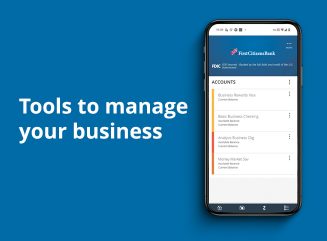
Digital banking for business
Seamlessly access all of your accounts from one place with First Citizens Digital Banking for business.

Control your portfolio
Invest how you want, when you want, in real time with Self-Directed Investing.

Digital banking for business
Seamlessly access all of your accounts from one place with First Citizens Digital Banking for business.
See how we're supporting companies
We're committed to serving companies as they expand and succeed. The proof is in our success stories.
Q4 Quarterly Market Review: Available now
The Making Sense team reviews changes in the market during Q4 2025.
Whether you're making an order at a local bakery or shopping at your favorite clothing store, the best customer service often feels the most personal. This is especially true today, as companies now have access to tons of customer data based on their in-store and online interactions.

These digital breadcrumbs provide clues for how to successfully hyper-personalize the customer experience. However, achieving hyper-personalization at scale takes data and technology investments—and requires your business to adopt a customer-first mindset.
Hyper-personalization involves using data and analytics to tailor the experience customers have with your business. It's about giving them a consistent experience across all your marketing channels and making them feel less like they're one of many, and more like they're your most valued customer.
A study by Deloitte found 90% of customers say personalized advertising is appealing. Personalized marketing also can drive conversions, customer loyalty and engagement, as 80% of consumers are more likely to buy from companies that offer personalized experiences.
Hyper-personalization can take several forms. It's the reason that a consumer might be served an ad for an all-inclusive vacation immediately after reading a post on a travel blog. It's also behind that sponsored ad for a discounted dining room table in someone's Instagram feed after they searched Google for dining chairs. Cookies, which are files a web server sends to an internet browser, help to make this happen by allowing companies to gather insights about what a consumer is interested in when they land on their site and then visit other pages on the internet. Your business also can gather more insights when customers subscribe to your newsletter, create a profile on your website, follow your social media pages or enroll in your loyalty program.
All these interactions offer valuable data points your company can use to deliver relevant messaging at every stage of the customer journey. They can help you provide an experience that encourages customers to do business with you again.
Technology is key for hyper-personalization. Fortunately, there are many artificial intelligence-driven, cloud-based applications available that can automate data collection and allow you to securely store and deploy customer data to create personalized experiences, often in near-real time.
You can use a customer relationship management platform to store customer data and create customized marketing campaigns for different audiences. Your website also offers a wealth of identifiable and anonymized customer data. If you run a furniture store and have a website, for example, you can see the most viewed items or the most frequently purchased items. If you have a restaurant and take online orders on your website or a third-party delivery app, you can access analytics that provide insight into the most popular menu items, the average order amount and customer reviews. All these tools can help you deliver personalization at scale, especially if you rely on a single platform that integrates all these capabilities—and your customer data—in one place.
You can personalize your customer experience in several ways. For example, your clothing store can provide tailored recommendations to a customer based on their previous order history once they log into your website. If you own a wine shop, you can use email marketing software to send a personalized email to customers who purchased something last month and offer them 10% off their next order using a special code. If they've already set up a profile on your website and your site has a built-in recommendation engine, you can use it to further customize their experience and show them other wines that are similar to their previous purchases. If a customer is enrolled in your loyalty or rewards program and provides their personal information, you can send them a special gift or discount offer via email during the holiday season or on their birthday.
With the help of AI-driven and cloud applications and software platforms, getting to know your customers has become significantly less labor- and time-intensive. These tools help you discover patterns and trends in how customers interact with your business so you can use this information to better serve them.
To be competitive and generate repeat business, it's key to make the right investments that will help you build a relationship with customers and understand their specific needs and wants. Adapting your marketing channels to personalize your products or services is the best way to build lasting customer relationships that drive revenue, sales and loyalty for your business.



This material is for informational purposes only and is not intended to be an offer, specific investment strategy, recommendation or solicitation to purchase or sell any security or insurance product, and should not be construed as legal, tax or accounting advice. Please consult with your legal or tax advisor regarding the particular facts and circumstances of your situation prior to making any financial decision. While we believe that the information presented is from reliable sources, we do not represent, warrant or guarantee that it is accurate or complete.
Third parties mentioned are not affiliated with First-Citizens Bank & Trust Company.
Links to third-party websites may have a privacy policy different from First Citizens Bank and may provide less security than this website. First Citizens Bank and its affiliates are not responsible for the products, services and content on any third-party website.
First Citizens Bank & Trust Company is a Member FDIC and an Equal Housing Lender icon: sys-ehl.
NMLSR ID 503941

Treasury & Cash Management
Electronic Bill Presentment & Payment
Investment & Retirement Services
Community Association Banking
Equipment Financing & Leasing
Credit Cards
Merchant Services
Email Us
Please select the option that best matches your needs.
Customers with account-related questions who aren't enrolled in Digital Banking or who would prefer to talk with someone can call us directly.